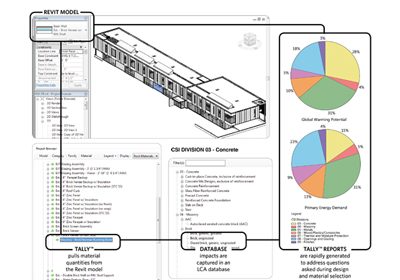Philadelphia architect KieranTimberlake has released a beta version of Tally, a software application allowing users to measure building materials’ and products’ environmental impact directly in Autodesk’s Revit—a key software program to support building information modeling.
| Tally software provides life cycle assessment data on concrete and steel—yellow and green on the pie charts, respectively—and other materials and products early in the design stage. In response to new requirements in LEED v4, Challenge 2030 and other rating systems or project benchmarking efforts, green building practitioners are increasingly weighing LCA data in specifications. |
The application provides Life Cycle Assessment (LCA) figures on demand, backed by the rigor and credibility of data generated by the GaBi program from PE International, a global leader in life cycle information and sustainability consulting. Autodesk, the maker of Revit modeling software, supported Tally development and testing. The KieranTimberlake program offers a dramatic shift from traditional LCA methodologies, often compiled by trained practitioners. Conducting LCAs for buildings and construction has typically been time and labor intensive, with most assessments performed after construction is already complete. Tally puts LCA information in the hands of the design team, enabling life cycle-based material and product decisions within the same working environment as building designs are generated.
“Tally takes a big step in driving Life Cycle Assessment into the design process. It is appealing to designers because they don’t need to make a separate model for analysis, and it creates a streamlined and intuitive interface for designers to interact with their models,” says Frances Yang, a structures and materials sustainability specialist at Arup, who beta-tested Tally in the firm’s San Francisco office. “As with energy modeling tools, it matters that the person driving the model has access to deciding factors instead of waiting for third-party results. It’s important to close that gap so that iterations can be made faster.”
LCA is part of a larger framework for reducing buildings’ environmental impact, which includes current standards such as Passive House, Living Building Challenge, and the 2030 Challenge aimed at reducing energy consumption. As energy codes become more stringent and operations-related environmental impacts drop, the demand for LCA results is mounting. New standards, such as the U.S. Green Building Council’s LEED v4, reward project teams that utilize whole building LCA via a new materials and resources credit. Tally is an environmental impact tool created by architects for the architecture industry, KieranTimberlake notes. The firm developed the application using Autodesk’s Revit API in order to link BIM elements with a custom-designed LCA database. The software combines material attributes, assembly details, and engineering and architectural specifications with environmental impact data to produce reports designers can use to analyze material selections. With Tally, users can track the environmental impact of materials across a range of categories, such as embodied energy and global warming potential.
“Our customers seek to provide the highest quality buildings at the most competitive price, and yet until recently, the prospect of quickly gathering insight into the embedded environmental impacts of construction materials and products proved too daunting,” says Autodesk Sustainability Solutions’ Emma Stewart. “Tally unites BIM models with credible life cycle data to make this not only feasible, but a new best practice.”
KieranTimberlake conceived the application in 2008 and began refining it in partnership with Autodesk Sustainability Solutions. The beta version was presented during Greenbuild 2012 in San Francisco and at Autodesk University. In 2013, Tally underwent a nineweek beta testing phase by architecture, engineering, and construction firms, including Arup, Snohetta, and Lend Lease. The inaugural Tally version was previewed in November at Greenbuild 2013, Philadelphia, and will be available as a free public beta through March. — http://ktrg.kierantimberlake.com/tally
Tally software provides life cycle assessment data on concrete and steel—yellow and green on the pie charts, respectively—and other materials and products early in the design stage. In response to new requirements in LEED v4, Challenge 2030 and other rating systems or project benchmarking efforts, green building practitioners are increasingly weighing LCA data in specifications.
